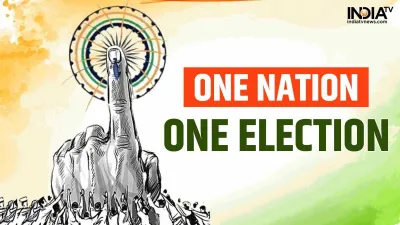Understanding the 'One Nation, One Election' Bill: A Transformative Yet Contentious Proposal
8 min read

The introduction of the ‘One Nation, One Election’ Bill in the Lok Sabha has sparked significant political and public discourse. This proposal, aiming to synchronize Lok Sabha and state assembly elections, has implications that extend far beyond the electoral schedule, touching on India’s federal structure and democratic ethos.
What is the ‘One Nation, One Election’ Bill?
The ‘One Nation, One Election’ bill, formally known as the Constitution (129th Amendment) Bill, was introduced in the Lok Sabha during the Winter Session. It proposes amendments to align Lok Sabha elections with state assembly elections, potentially streamlining the electoral process. Another accompanying legislation, the Union Territories Amendment Bill, seeks to synchronize elections in Union Territories like Delhi, Puducherry, and Jammu and Kashmir with national polls.
Key Developments in Parliament
Union Minister Arjun Meghwal introduced the bill following a 90-minute debate. The vote on the bill saw 269 members in favor and 198 against. Home Minister Amit Shah emphasized the necessity of detailed deliberations, proposing a Joint Parliamentary Committee (JPC) to analyze the bill’s implications thoroughly before Cabinet and House discussions.
Political Reactions
The BJP’s Stand
The ruling Bharatiya Janata Party (BJP) has been a strong advocate of the bill, asserting that synchronized elections would save resources and ensure governance continuity. A strict three-line whip was issued to its Lok Sabha MPs to attend the voting, with notices now being served to 20 absentees.
Opposition Critique
- Federal Concerns: Opposition parties, including Congress, DMK, and AIMIM, have criticized the bill for undermining the federal structure. Congress leader Manish Tewari called it an “assault on the Constitution’s basic structure,” while AIMIM’s Asaduddin Owaisi warned of its impact on regional parties.
- Corporate Agenda Allegations: Farmers’ group Samyukt Kisan Morcha (SKM) accused the bill of facilitating corporate exploitation by centralizing power and eroding state autonomy.
1. Historical Context
- Add a section about India’s electoral history and the practice of simultaneous elections during the first few decades after independence. This provides context for why the bill is significant.
- Example: “India conducted simultaneous elections for the Lok Sabha and state assemblies from 1951 to 1967. This practice was disrupted due to the premature dissolution of some state assemblies and the Lok Sabha.”
2. Real-Life Scenarios
- Include hypothetical examples to illustrate how the bill would impact governance or voting patterns.
- Example: “Imagine a voter in Tamil Nadu voting for both the state assembly and Lok Sabha on the same day. While this simplifies logistics, it may lead to national issues overshadowing local concerns.”
3. Global Comparisons
- Discuss how other democracies handle their election schedules and the advantages or drawbacks they face.
- Example: “Countries like South Africa and Sweden hold simultaneous elections to streamline governance. However, critics in these countries argue that local issues often get sidelined.”
4. Expert Opinions
- Incorporate quotes or references from constitutional experts, political analysts, or former election commissioners.
- Example: “Former Chief Election Commissioner XYZ remarked, ‘While the concept of One Nation, One Election has merit, its execution must address India’s federal complexities.’”
5. Visuals or Infographics (if applicable)
- Suggest creating an infographic summarizing the advantages and challenges of the bill. Use charts or maps to highlight voting trends or potential impacts.
6. Public Opinion
- Add perspectives from citizens, perhaps from social media or surveys.
- Example: “A recent poll conducted by XYZ News revealed that 56% of respondents favored the bill, citing reduced election fatigue, while 44% expressed concerns about federalism.”
7. Future Scenarios
- Discuss potential long-term effects on India’s political landscape, including the fate of regional parties.
- Example: “If implemented, the bill could redefine the role of regional parties, potentially diminishing their influence in a unified electoral cycle.”
8. Call to Action or Open Questions
- Engage readers by inviting their opinions or posing questions.
- Example: “Do you believe the ‘One Nation, One Election’ Bill will strengthen or weaken India’s democracy? Share your thoughts below.”
Implications of the Bill
Advantages
- Cost Efficiency: Conducting simultaneous elections could reduce the expenditure incurred during staggered elections.
- Administrative Focus: Governments at all levels could focus on governance rather than being in constant campaign mode.
- Voter Convenience: A single election cycle may reduce voter fatigue and enhance turnout.
Challenges
- Federalism at Stake: Critics argue that the bill threatens the federal structure by prioritizing centralization over state autonomy.
- Implementation Hurdles: Aligning terms of various legislatures could lead to constitutional and logistical complexities.
- Democratic Risks: Simultaneous elections might overshadow local issues, shifting focus to national narratives.
Conclusion: A Balancing Act
The ‘One Nation, One Election’ Bill presents a vision of electoral reform aimed at efficiency and coherence. However, its potential to disrupt India’s delicate federal balance and democratic diversity cannot be overlooked. While the BJP seeks to push this transformative agenda, the strong opposition underscores the need for detailed deliberations and broader consensus. As the JPC examines the bill’s intricacies, India awaits a nuanced approach that respects both efficiency and the democratic fabric of the nation.